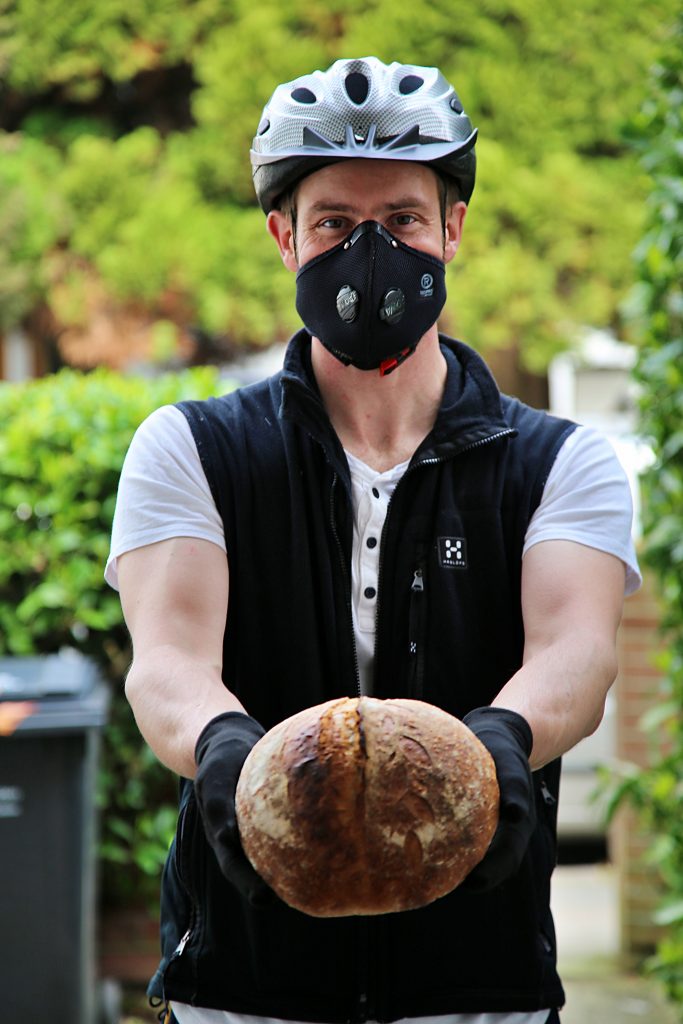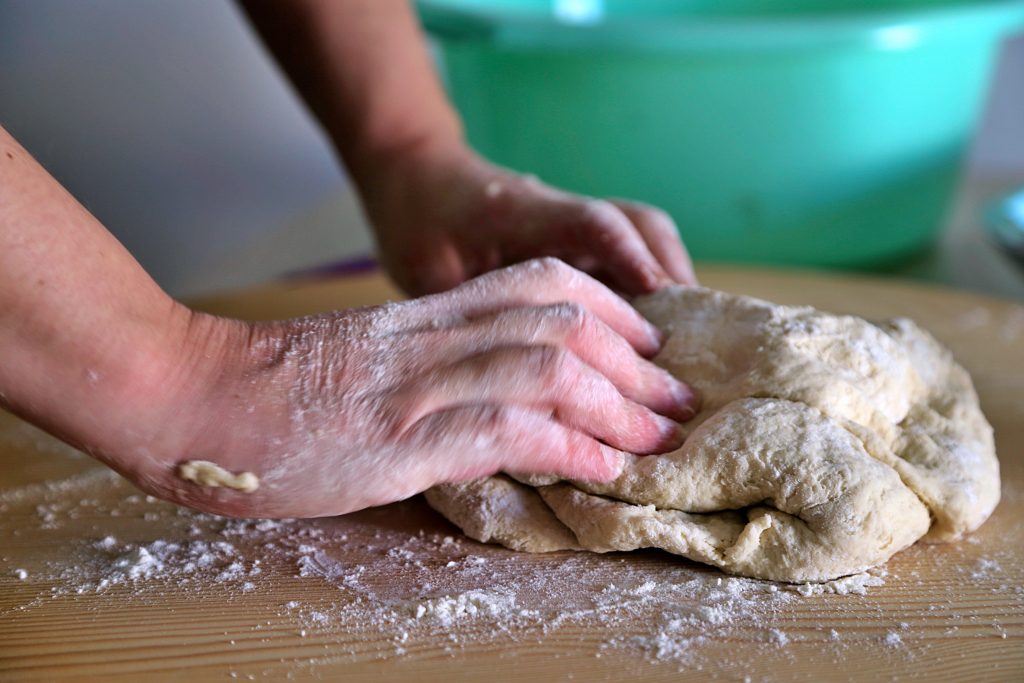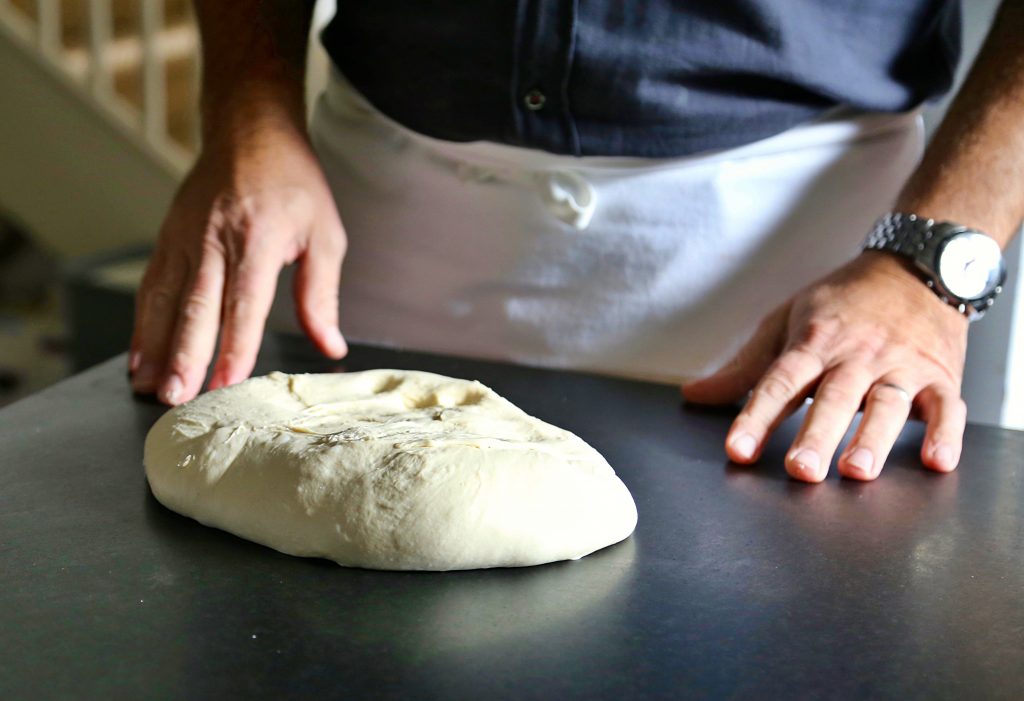
Making a sourdough starter has become a coronavirus lockdown meme, with some people complaining on Twitter that their boyfriends are more involved with their starters than their relationships. Sourdough is a bread that doesn’t need commercial yeast, which is in short supply. Instead, it rises via the invisible micro-bacteria in the air. This is healthy for your gut microbiome and pleasantly sour. Sourdough is time consuming, the ultimate in slow food, as you will see from the recipe below. But let’s face it, are you busy right now?
As restaurants, bars and chefs have been prevented from working, people are creatively pivoting their businesses to delivery instead. Sean Chambers, 39, born and bred in North West London, has been a chef for 20 years. Working as a private directors’ chef at a City of London insurance company prior to the lockdown, Sean already had plans to start a weekend bakery from his home in Cricklewood. He installed a professional Rofco oven in his garden shed.
Sean made a small announcement on the Next Door app saying that he made sourdough loaves and baguettes which led to local people getting in touch. Demand during the coronavirus has been such that he now feels he could go full time as a micro-bakery. Currently Sean makes 30 loaves a day, 115 baguettes while his wife Megan, a trained pastry chef, makes 50 croissants a day. All this while home-educating their two children, 8 and 5 years old.
‘I’ve spent years developing my sourdough recipe. My ‘mother’ is three and a half years old and is made from wholewheat, rye and white flour.’
What’s your routine? I asked him, as he handed over from the doorstep a still warm loaf of bread with a crusty shell and a rich flavour. Another advantage to sourdough, it lasts several days. And don’t waste the stale stuff, use as breadcrumbs, croutons or in a stale bread salad.
‘I get up at 2am to preheat the oven then I go back to bed for an hour. From 3am to 8.30am, I bake the loaves. I can only get 6 loaves in the oven at a time and each batch takes 30 minutes. Then I get on my bike, self-protecting of course, wearing gloves and a mask, and deliver to Maida Vale, Hampstead, Kilburn and Golders Green. Last of all I deliver to my neighbours in Cricklewood.’
‘In the afternoon, I’m making dough, 26 kilos at a time, all hand-kneaded for the next day, refrigerating it overnight. I’m in bed by 7.30pm, about the same time as the kids. I’m exhausted but I really enjoy being able to provide good bread to my area. I’m looking into getting a giant mixer, which will make things easier. I’ve now got a contactless card machine or people can pay via Paypal.’
Sourdough Mother Recipe
This will take around a week to get up and running, especially if the weather is warm as it is right now. Once your starter is bubbling and active, continue to maintain it. Some sourdough starters are extremely old, for instance the pizzeria Franco Manca claims their ‘mother’ is 300 years old, and originally from Italy.
A note on flour:
Where to get flour? I suggest asking on your local Mutual Aid groups, or the Next Door app or ordering online from Shipton Mill. I find small corner shops have better supplies of flour than supermarkets.
Look at the side of the pack and see how much protein is in the flour. Usually bread baking requires 12g of protein but if you only have plain or low protein flour, it will still work but will produce a less crusty chewy loaf.
A starter is best made with a combination of rye and white flour or wholewheat and ideally organic in order to have as much natural bacteria as possible. But baking in the time of Corona means use whatever you have!
Mother recipe:
50g flour
50ml water
Combine these ingredients in a clean glass jar, covered with a cloth and elastic band. Draw a line on the jar at the top of the mixture so you can see how much it rises. Leave this starter in a warm place to develop. Stir it a couple of times a day with a clean spoon.
Every 24 hours ‘refresh’ the starter by transferring the starter to a clean jar and add another 50g flour and water.
On day 5, you can discard or use (in pancakes or any savoury baking) all but 50g of the starter. Continue to refresh and discard every day.
By day 8, it should be bubbly with a pleasant sour smell and ready to use.
Now you only need to refresh the starter every 2 or 3 days and eventually, just once a week or the day before baking. If you go away or don’t bake very often, keep it in the fridge. Always keep a small amount back before using it to bake, and top it up again with flour and water. This means you always have an ongoing starter.

Sourdough loaf recipe.
This is a two stage process. Start the afternoon before you want to bake in the morning. Or in the morning if you want to bake in the evening.
Starter:
36g mother
106ml water
100g white flour
80g wholewheat or rye flour
Mix and leave for 4 to 5 hours to ferment.
Dough Recipe:
To make 3 x 500g loaves
322g starter
470ml water
720g flour
15g salt
Flour or rice flour or fine semolina for dusting.
Combine starter, water, flour and salt in a bowl. Pull the dough from the sides into the centre for 5 minutes. Leave for 30 minutes, stretch and fold the dough.
Do this 3 more times at 30 minute intervals.
Divide the dough in three and pre-shape the dough.
Put into bannetons or a metal/plastic bowl lined with a tea towel dusted with flour. Or form into round loaves on a baking tray and cover with a tea towel.
Dust with flour or rice flour.
With a sharp knife, scissors or razor blade, make a cut ‘scoring’ on top of the loaf to allow it to expand during baking.
Refrigerate or keep cool overnight for a slow rise.
In the morning:
Pre heat the oven an hour beforehand.
Turn out the loaves from the bowl/banneton and bake inside either a pre-heated Dutch oven/heavy lidded casserole dish (remove the lid for the last 10 minutes) or on a tray or stone at 265ºC for 30 minutes.
Remove from the oven and let it cool.
Tip: You can check that the gluten has developed by taking a small piece of the dough and stretching it. Hold it up to the light and if it forms a ‘window’, the dough is ready.
Tip: When kneading, do not add flour to the surface or your hands. To prevent your hands becoming sticky, dip them in water repeatedly. As the gluten relaxes, the dough will become less sticky.
Contact Seansloaf.co.uk or @seansloaf on instagram





Leave a Reply